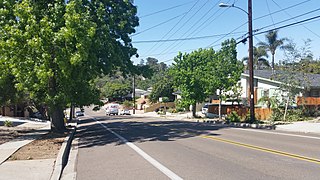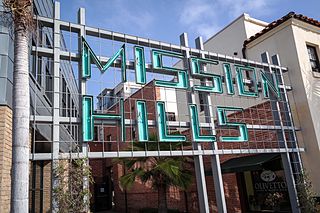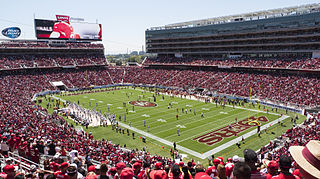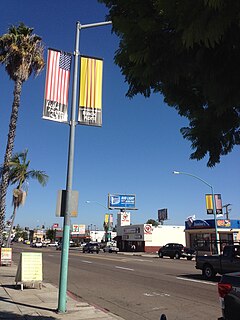Related Research Articles

Street racing is typically an unsanctioned and illegal form of auto racing that occurs on a public road. Racing in the streets is an ancient hazard, as horse racing occurred on streets for centuries, and street racing of automobiles is as old as the automobile itself. It became especially prevalent during the heyday of hot rodding and muscle cars, and it continues to be both popular and hazardous, with deaths and maiming of bystanders, passengers, and drivers occurring every year. In the United States, modern street racing traces its roots back to Woodward Avenue, Michigan in the 1960s when the three main Detroit-based American car companies were producing high-powered performance cars. A private racing venue was not always available, and therefore the race would be held illegally on public roads.

The College Area is a residential community in the Mid-City region of San Diego, California, United States. The College Area is dominated by San Diego State University, after which the area is named. Several neighborhoods in the College Area were developed in the 1930s, with others becoming established in the post-war period. The College Area is bordered on the west by Kensington and Talmadge and on the east by the city of La Mesa. El Cajon Boulevard is a busy shopping district; additional retail is in development near SDSU.

North Park is a neighborhood in San Diego, California, United States, as well as a larger "community" as defined by the City of San Diego for planning purposes. The neighborhood is bounded:

City Heights is a dense urban community in central San Diego, California, known for its ethnic diversity. The area was previously known as East San Diego. City Heights is located south of Mission Valley and northeast of Balboa Park.

Cruising is a social activity that primarily consists of driving a car. Cruising can be an expression of the freedom of possessing a driver's license. Cruising is distinguished from regular driving by the social and recreational nature of the activity, which is characterized by an impulsively random, often aimless course. A popular route is often the focus of cruising. "Cruise nights" are evenings during which cars drive slowly. A cruise can be a meeting of car enthusiasts at a predetermined location, organised predominantly through the internet but also largely through mobile phone, word of mouth or simply by a cruise being established enough that it becomes a regular event.

Hourglass Field was the popular name for an auxiliary landing field operated by the United States Navy before and during World War II in the northern part of San Diego, California. It is remembered as a racetrack in the regional road racing circuit and because a crackdown on unauthorized drag racing there triggered the El Cajon Boulevard Riot. A community college now occupies the site. Its athletics complex and a community park adjacent to the college are named after the airfield.

Mission Hills is an upscale affluent neighborhood of San Diego, California, USA. It is located on hills just south of the San Diego River valley and north of downtown San Diego, overlooking Old Town, Downtown San Diego, and San Diego Bay.

California currently has 18 major professional sports franchises, far more than any other US state. The San Francisco Bay Area has six major league teams spread amongst three cities: San Francisco, Oakland and San Jose. The Greater Los Angeles Area has ten major league teams. San Diego and Sacramento each have one major league team.
El Cerrito, Spanish for "the little hill," is a neighborhood of the Mid-City region of San Diego, California. El Cerrito is a residential neighborhood, consisting mostly of suburban homes, with some commercial activity along the streets that define its borders.

El Cajon Boulevard is a major east–west thoroughfare through San Diego, La Mesa and El Cajon, California. Before the creation of Interstate 8 it was the principal automobile route from San Diego to El Cajon, the Imperial Valley, and points east as U.S. Route 80; it is now signed as a business loop of Interstate 8.
The Chaldean mafia is a criminal organization composed of Chaldeans that have operated narcotics distribution networks from Phoenix and San Diego to Detroit. Involved in violent crimes such as homicide, assault, kidnapping, armed robbery, and arson, the gang uses intimidation and brutal force to move the narcotics and collect drug proceeds.
Frederick R. DiNome was a professional drag racer and a member of the DeMeo crew, headed by Gambino soldier Roy DeMeo. He later became a government witness and testified against many Gambino crime family members.
U.S. Route 80 (US 80) was a U.S. highway in California that continued east across the country to Georgia. The western terminus of US 80 was in San Diego, California, and it continued east through the city on several different alignments through the years. The highway went through the Cuyamaca Mountains, encountering many switchbacks, before descending to El Centro. After passing through the sand dunes, the highway crossed the Colorado River into Yuma, Arizona.
Super Shops Automotive Performance Centers was an American chain of 165 aftermarket auto parts stores which operated from 1963 to 1998. The chain was founded as a single store on July 1, 1963, by Harry Eberlin, a United States Air Force Veteran and freelance auto-parts dealer. Initially named San Bernardino Racing Equipment, the first store was located at 25824 East Baseline Road in San Bernardino, California. After the opening of several stores, the corporation changed names in 1977 from San Bernardino Racing Equipment Inc. to Super Shops, Inc. The chain rebranded its stores as Super Shops Automotive Performance Centers in 1978. The Super Shops chain sponsored racing events and National Hot Rod Association drag racing teams. The corporation went out of business in 1998 due to a series of bad business decisions and financial debt.
30th Street is a major north-south road in San Diego, California on the east side of Balboa Park. It connects several of the densest urban communities of Central San Diego and has a high rate of pedestrian activity. In recent years, 30th Street has become known nationally for its prominent craft beer culture.

Alfred John Young is a former World Champion Drag Racer and National Hot Rod Association Hall of Famer who competed in professional Bracket racing, and the heads-up categories from Super Street and Super Gas to Super Comp. He taught high school in Seattle, Washington, for 37 years, and is involved with the preparation of classic high performance race cars. After campaigning his 1970 Dodge Challenger for over 25 years, winning the American Hot Rod Association (AHRA) World Championship and numerous other National Hot Rod Association and AHRA titles, he donated his drag racing car to the Museum of History and Industry (MOHAI) in Seattle, Washington, in 2007. During the majority of his auto racing career, he was sponsored by Ole Bardahl of the Bardahl Company. In 2018, he was inducted into the National Hot Rod Association, Northwest Division, Hall of Fame.
Chuck Beal Racing is a drag racing company owned by professional drag racer Chuck Beal. The company is located in San Diego, California. Chuck Beal started as a racer of front- and rear-engine vehicles until he changed to the alcohol funny car class and then nitro-class vehicles. His grandson Brandon Welch took over the duties of racing his Funny Car after having graduated from Frank Hawley's Drag Racing School. He also serves as the Vice President of Marketing. Other racers who have raced for Chuck Beal include Jeff Arend and Jeff Diehl. The company's vehicles have multiple sponsors, including AutoAnything, UnderCover Truck Bed Covers, TruXedo Tonneau Covers, ProZ, and TruXP.
The shooting of Alfred Olango occurred in El Cajon, California, United States on September 27, 2016. Olango, a 38-year old former refugee from Uganda, was shot several times by police responding to a call for emergency psychiatric aid. He died later that day in a hospital. Officers on scene claimed to have believed Olango was pointing a firearm; the object in his hand was an e-cigarette. The shooting sparked days of protests in El Cajon and around San Diego County.

There have been a series of protests and riots in California related to the death of George Floyd on May 25, 2020 in Minneapolis while in police custody. On May 31, 2020, the California Department of Human Resources advised "all state departments with offices in downtown city areas" to close on June 1.

Little Saigon, San Diego is a Vietnamese enclave in City Heights, San Diego, located on El Cajon Boulevard between Euclid and Highland avenues.
References
- ↑ http://legacy.sandiegouniontribune.com/uniontrib/20080717/news_1ez17history.html
- ↑ http://legacy.sandiegouniontribune.com/uniontrib/20080717/news_1ez17history.html
- ↑ https://www.jalopyjournal.com/forum/threads/1960-san-diego-drag-street-riots.688267/
- ↑ http://legacy.sandiegouniontribune.com/uniontrib/20080717/news_1ez17history.html
- ↑ http://johnstraub.blogspot.com/2010/08/san-diego-rodders-riot.html